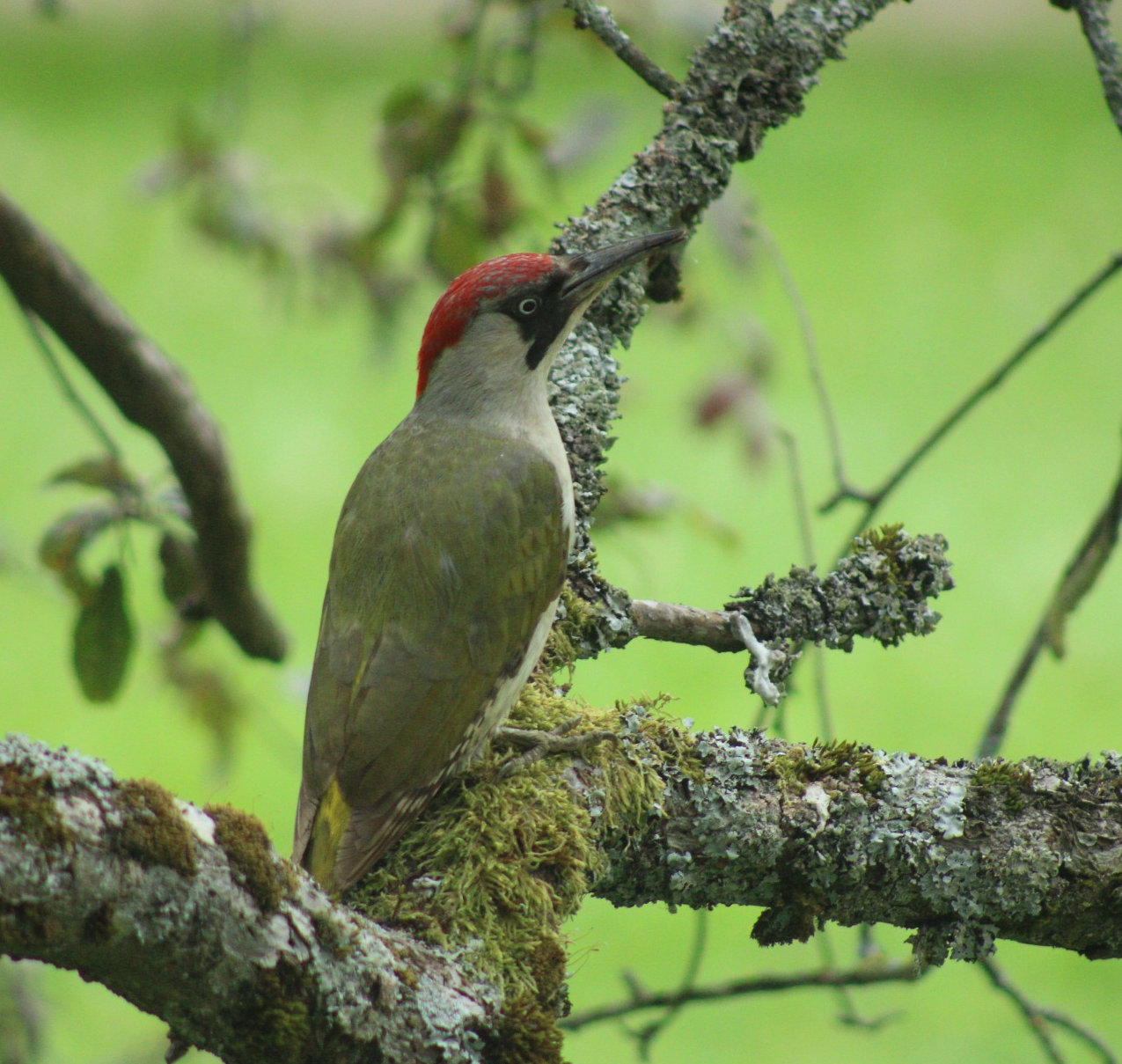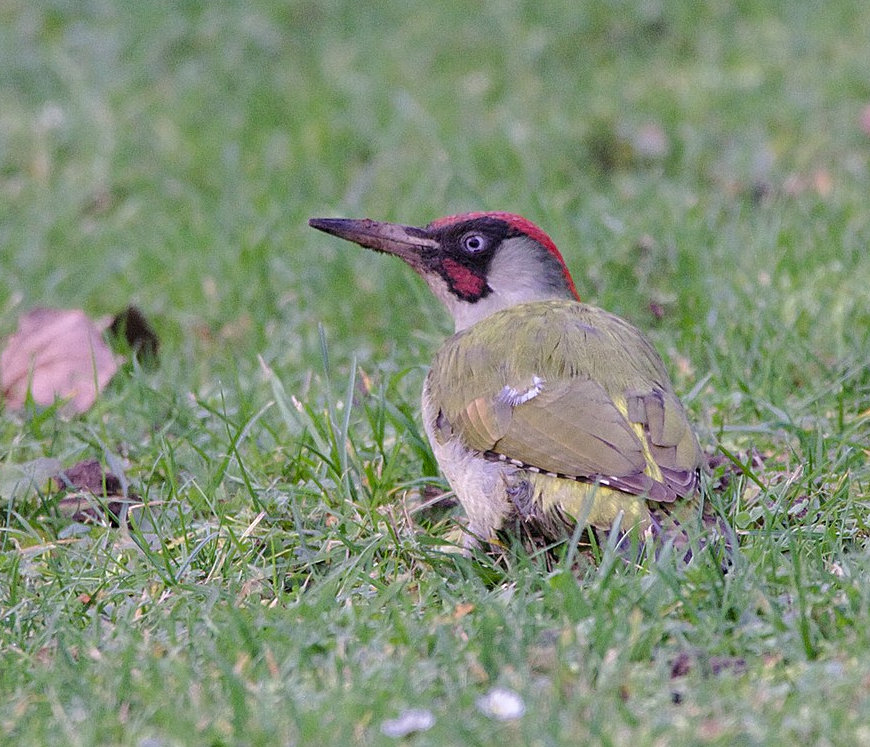Garden Wildlife
Garden Wildlife


What do they eat?
While they do forage for insects on the bark of trees, green woodpeckers are mainly ground feeders. They are particularly keen on raiding ant nests, and when seen in the garden they are usually hopping across the lawn and pecking, scooping up ants and their larvae with a long sticky tongue adapted in the same way as those of anteater mammals. In winter they will also take berries, fruit and nuts and compete with migrant thrushes for windfall apples, but they don’t come to bird feeders.
Where do they breed?
They nest in a hole in a decaying part of a large tree, and they are less effective woodworkers than other species with stronger bills. They have one annual brood of up to 7 eggs in May and June.
What do they do?
They are quite wary of people and so what you tend to see is the back view of a green woodpecker flying away with its distinctive undulating flight. They are a bit ungainly on the ground, hopping heavily with their heads in the air.
How are they doing
Green woodpeckers are pretty much confined to southern, central and eastern England and south Wales, but there are some to be seen in eastern Scotland. They don’t occur in Ireland. There are estimated to be about 45,000 pairs in Britain, down by about 21% over the last ten years in England, but still 15% higher than in 1995, so they are of some concern especially in Scotland where the decline is greater.
Finding out more:
BTO profile on green woodpecker
RSPB profile on green woodpecker
Page written and compiled by Steve Head
Green woodpecker Picus viridis
These are our largest woodpeckers and although not common in gardens – being reported by only about 3% of garden recorders, they are a fine sight when you do see them. See our tree-dwellers page for comparison photos.


Female (black moustache) Male (red patch in moustache)
What do they look like?
They are quite big birds at 32 cm length, about the size of a collared dove. They have an overall green colour, with a prominent red cap, and the males have a red streak on their “moustache” while that of the female is uniformly black. When they fly you see an obvious yellow rump, and they have an equally distinctive undulating flight.
What do they sound like?
They have two basic calls. Both sexes make a “chiu-chiu-chiu” call in flight. The male’s territorial call is a very distinctive laughing song, in descending tones, which gave rise to the common name of “yaffle” for the bird. They don’t drum as often as other woodpecker species.
Flight call Male's yaffle
Domagoj Tomičić, XC703056. Accessible at www.xeno-canto.org/703056.
Stanislas Wroza, XC672878. Accessible at www.xeno-canto.org/672878
Green woodpecker Picus viridis
These are our largest woodpeckers and although not common in gardens – being reported by only about 3% of garden recorders, they are a fine sight when you do see them. See our tree-dwellers page for comparison photos.


Female (black moustache) Male (red patch in moustache)
What do they look like?
They are quite big birds at 32 cm length, about the size of a collared dove. They have an overall green colour, with a prominent red cap, and the males have a red streak on their “moustache” while that of the female is uniformly black. When they fly you see an obvious yellow rump, and they have an equally distinctive undulating flight.
What do they sound like?
They have two basic calls. Both sexes make a “chiu-chiu-chiu” call in flight. The male’s territorial call is a very distinctive laughing song, in descending tones, which gave rise to the common name of “yaffle” for the bird. They don’t drum as often as other woodpecker species.
Flight call Male's yaffle
What do they eat?
While they do forage for insects on the bark of trees, green woodpeckers are mainly ground feeders. They are particularly keen on raiding ant nests, and when seen in the garden they are usually hopping across the lawn and pecking, scooping up ants and their larvae with a long sticky tongue adapted in the same way as those of anteater mammals. In winter they will also take berries, fruit and nuts and compete with migrant thrushes for windfall apples, but they don’t come to bird feeders.
Where do they breed?
They nest in a hole in a decaying part of a large tree, and they are less effective woodworkers than other species with stronger bills. They have one annual brood of up to 7 eggs in May and June.
What do they do?
They are quite wary of people and so what you tend to see is the back view of a green woodpecker flying away with its distinctive undulating flight. They are a bit ungainly on the ground, hopping heavily with their heads in the air.
How are they doing
Green woodpeckers are pretty much confined to southern, central and eastern England and south Wales, but there are some to be seen in eastern Scotland. They don’t occur in Ireland. There are estimated to be about 45,000 pairs in Britain, down by about 21% over the last ten years in England, but still 15% higher than in 1995, so they are of some concern especially in Scotland where the decline is greater.
Finding out more:
Page written and compiled by Steve Head
























